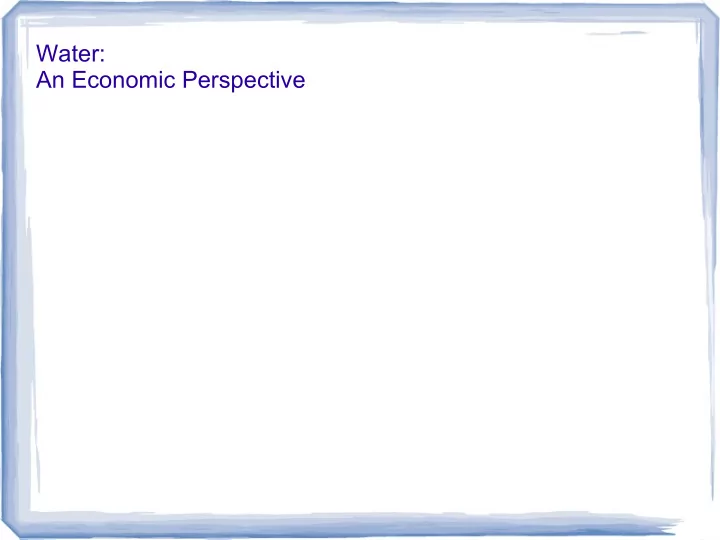

Water: An Economic Perspective
Water: The Hydrological Cycle
Water: The Hydrological Cycle 2 sources readily available for human exploitation: 1. Surface water Rivers, lakes, reservoirs 2. Groundwater Collects in porous layers of underground rock, called “aquifers”
Water: The Hydrological Cycle Note: - some groundwater is recharged, through percolation of rainwater and snowmelt - most groundwater is not recharged, except over geologic time scales Estimate: 16,000 trillion gallons of U.S. groundwater 400 trillion “recharged” annually, and therefore renewable
Water: Withdrawals, 2005
Water: Withdrawals, 2005
Water: Withdrawals by state, 2005
Water: Withdrawals by state, 2005
Water: Withdrawals by state, 2005
Water: Unsustainable use in Arizona Example: Tuscon, AZ -Annual rainfall: 11” -Surface water? Not so much -Population explosion ==> aquifer down 100 feet in 10 years! Estimate: aquifer exhausted in 100 years Estimate: pumping rate roughly 5x the natural recharge rate
Water: Unsustainable use in California Surface Water Resource: 200m. acre-feet/year rainfall 7 m. acre-feet/year (Colorado & Klamath Rivers) _________ =207 m. a.f./yr Net Surface Water 2/3 evaporation/transpiration 1/3 (i.e. 71 m. a.f.) as annual runoff Groundwater: 850 m. a.f. available 14 m. a.f. withdrawn annually (12.5 m.a.f. annual recharge) _________ =1.5 m.a.f. overdraft
Water: Unsustainable use in California Specific Uses: Eco-system maintenance (necessary in-stream flows): average 36.9 m.a.f./yr Net available: 71 - 36.9 = 34.1 m.a.f./yr 80% dedicated to agriculture 16% for urban 4% for recreation, wildlife, power generation Urban use growing @ 64 k.a.f./yr Populations projections show rapid growth in the driest areas
Water: Unsustainable use in California
Water: Unsustainable use in California
Water: Unsustainable use in California
Water: Unsustainable use in California
Water: An Economic Perspective Two kinds of efficiency: 1) Efficient allocation among competing uses (at a moment in time) 2) Efficient allocation across time (dynamic efficiency)
Water: An Economic Perspective (1) Efficient allocation among competing uses: -requires that MNBi = MNBj all i,j NOTE: this is similar to the equimarginal condition If MNBi > MNBj ==> i should get more, j should get less (i could compensate j, Pareto improvement) NOTE: in the case of non-storable Surface Water (river water, e.g.), this is the only efficiency criterion
Water: An Economic Perspective BUT: when there is storage (and scarcity), we also have: (2) Dynamic efficiency To maximize the present value of the flow of value from a finite, exhaustible resource: MNB t = MNB (t+1) /(1+i) all t, t+1 which brings us to: Groundwater
Water: Groundwater
Water: Groundwater
Water: Groundwater
Water: Groundwater
Water: Groundwater
Water: Groundwater
Water: Groundwater Exercise: Compare on Google Maps 1. Iowa 2. SW Nebraska
Water: Groundwater
Water: The Basic Economic Challenge 1) Static efficiency: equate MNB’s across sectors, at each moment in time - urban domestic, rural irrigation, industrial/commercial, etc. 2) Dynamic efficiency: equate present value of MNBs, across time
Water: The Basic Economic Challenge Question: How are we doing? Answer: Badly. Market failures all around. -lack of property rights make trading difficult -common pool resource problems make “storage” difficult -institutional details make efficiency pricing difficult
Recommend
More recommend